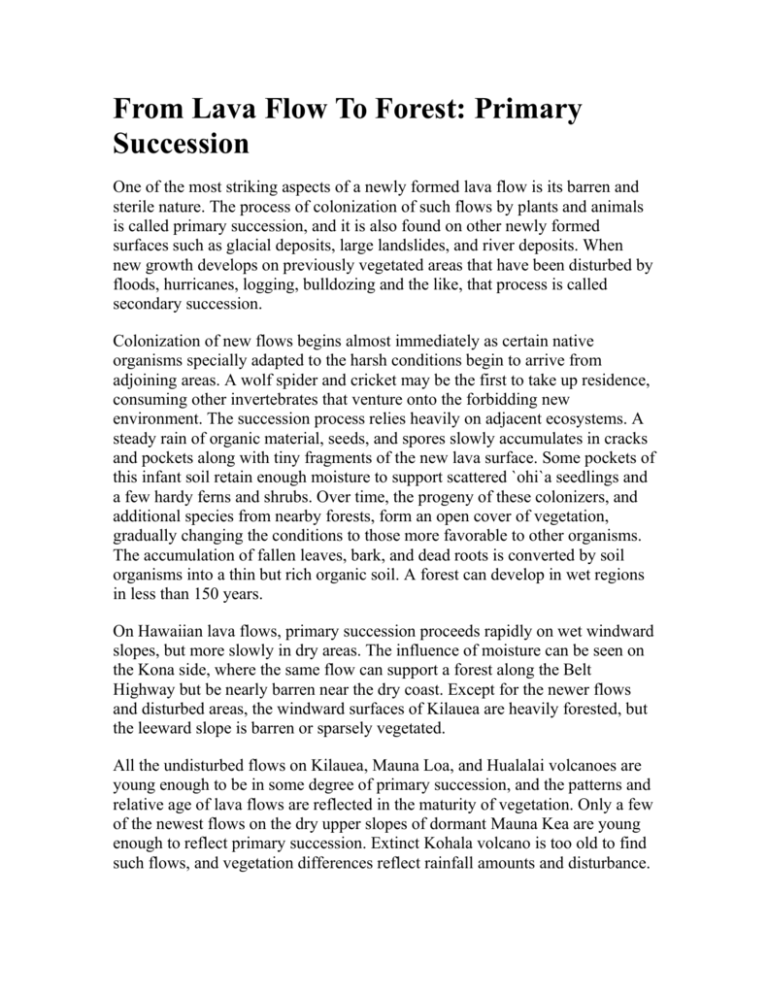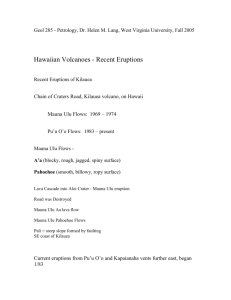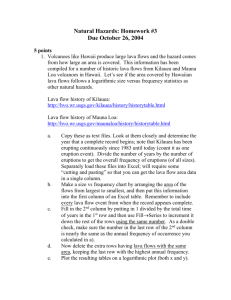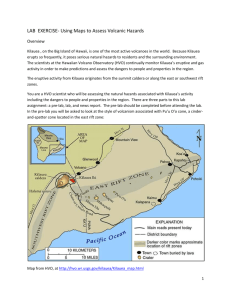From Lava Flow To Forest: Primary Succession
advertisement

From Lava Flow To Forest: Primary Succession One of the most striking aspects of a newly formed lava flow is its barren and sterile nature. The process of colonization of such flows by plants and animals is called primary succession, and it is also found on other newly formed surfaces such as glacial deposits, large landslides, and river deposits. When new growth develops on previously vegetated areas that have been disturbed by floods, hurricanes, logging, bulldozing and the like, that process is called secondary succession. Colonization of new flows begins almost immediately as certain native organisms specially adapted to the harsh conditions begin to arrive from adjoining areas. A wolf spider and cricket may be the first to take up residence, consuming other invertebrates that venture onto the forbidding new environment. The succession process relies heavily on adjacent ecosystems. A steady rain of organic material, seeds, and spores slowly accumulates in cracks and pockets along with tiny fragments of the new lava surface. Some pockets of this infant soil retain enough moisture to support scattered `ohi`a seedlings and a few hardy ferns and shrubs. Over time, the progeny of these colonizers, and additional species from nearby forests, form an open cover of vegetation, gradually changing the conditions to those more favorable to other organisms. The accumulation of fallen leaves, bark, and dead roots is converted by soil organisms into a thin but rich organic soil. A forest can develop in wet regions in less than 150 years. On Hawaiian lava flows, primary succession proceeds rapidly on wet windward slopes, but more slowly in dry areas. The influence of moisture can be seen on the Kona side, where the same flow can support a forest along the Belt Highway but be nearly barren near the dry coast. Except for the newer flows and disturbed areas, the windward surfaces of Kilauea are heavily forested, but the leeward slope is barren or sparsely vegetated. All the undisturbed flows on Kilauea, Mauna Loa, and Hualalai volcanoes are young enough to be in some degree of primary succession, and the patterns and relative age of lava flows are reflected in the maturity of vegetation. Only a few of the newest flows on the dry upper slopes of dormant Mauna Kea are young enough to reflect primary succession. Extinct Kohala volcano is too old to find such flows, and vegetation differences reflect rainfall amounts and disturbance. On wetter slopes of Hualalai and Mauna Loa, younger flows stand out against a more uniform, older background, as the surfaces are recovered by lava at rates of only 20 and 40 percent a century. Small and more active, Kilauea renews about 90 percent of its surface in the same time period, and the resulting pattern is a patchwork of flows and vegetated remnants (kipuka). The many younger flows rely on the older kipuka to provide sources of plants and animals. The native forest ecosystems have adapted to the overpowering nature of volcanic eruptions by being able to quickly recolonize from the many kipuka around new flows. However, the added losses due to forest clearing and alien invasion provide additional threats to which the native biota is not adapted. If too many of the native forest areas are cleared or taken over by introduced organisms, natural succession may not be able to provide a replacement native ecosystem on the younger flows. The continuing primary succession process may be already partially interrupted in lower Puna, where so much of the native forest has been cleared for development and where colonizers from nearby areas are mostly introduced organisms. Eruption Update Lava continued to erupt from Pu`u `O`o and flow through a network of tubes from the vent to the sea. No surface flows from breakouts of the tube system were observed on the coastal flats. Lava is entering the ocean near Kamokuna and forming a new bench. The public is reminded that the ocean entry areas are extremely hazardous, with explosions accompanying frequent collapses of the new land. Especially vigorous explosions took place on Monday and Tuesday, sending spatter to heights of 100 m (300 feet). The steam clouds are highly acidic and laced with glass particles. Two felt earthquakes were reported during the week ending on January 21. At 0610 a.m. on the 15th, a magitude 3.0 shake took place at a depth of 4 km (2.5 miles) beneath the upper east rift zone of Kilauea and was feld in the summit area. Later in the same day, at 1256 pm.m, residents of the Waimea-Waikoloa area felt an earthquake of magnitude 3.5 located northwest of Mauna Kea summit at a depth of 31 km (19 miles).











